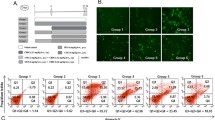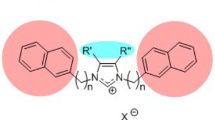Summary
The activity of three iron chelators, methyl [2′-(2-hydroxyphenyl)-2′-thiazoline-4′-carboxylate] (MTL); 2′-(2-hydroxyphenyl)-2′-thiazoline-4′-carboxylic acid (TFAL); and 2-hydroxyphenyl-imido-ethyl-ether (Imidate), regarding antiproliferative, cytocidal, and cell-cycle effects are reported and compared with hydroxyurea (HU). In vitro, against L1210 and P388 murine neoplasms, MTL and TFAL displayed substantially greater antiproliferative activity than HU, although Imidate displayed no appreciable activity. MTL also induced a statistically more complete G1/S cell-boundary block than did HU at equimolar concentrations (100 μM). The IC50 values produced by MTL and TFAL were low enough (≤20 μM)to warrant further testing of these chelators as potential antineoplastic agents.
Similar content being viewed by others
References
Bergeron RJ, Cavanaugh PF, Kline SJ, Hughes RG, Elliott GT, Porter CW (1984) Antineoplastic and antiherpetic activity of spermidine catecholamide iron chelators. Biochem Biophys Res Commun 121:848
Berman C (1958) Primary carcinoma of the liver. Adv Cancer Res 5:55
Bomford A, Williams R (1976) Long term results of venesection therapy in idiopathic hemochromatosis. Q J Med 45:611
Brockman RW, Shaddox S, Laster WL, Schabel FM (1970) Inhibition of ribonucleotide reductase, DNA synthesis, and L1210 leukemia by guanazole. Cancer Res 30:2358
Burns ER, Bagwell CB, Hinson WG, Pipkin JL, Hudson JL (1983) Preparation and stability of sixteen murine tissues and organs for flow cytometric cell cycle analysis. Cytometry 4:150
carpentieri U, Myers J, Thorpe L, Daeschner CW, Haggard ME (1986) Copper, zinc and iron in normal and leukemic lymphocytes from children. Cancer Res 46:981
Cavanaugh PF, Porter CW, Tukalo D, Frankfurt OS, Pavelic ZP, Bergeron RJ (1985) Characterization of L1210 cell growth inhibition by the bacterial iron chelators parabactin and compound II. Cancer Res 45:4754
Hoffbrand AV, Ganeshagura K, Hooton JWL, Tattersall MHN (1976) Effects of iron deficiency and desferrioxamine on DNA synthesis in human cells. Br J Haematol 33:517
Kelley W (1983) Ideopathic haemochromatosis: In: Harrison's Principles of Internal Medicine, 10th edn. McGraw Hill, New York, p 530
Lipsky MM, Hinton DE, Goldblatt PJ, Klaurig JE, Trump BF (1979) Iron negative foci and nodules in safrole-exposed mouse liver made siderotic by iron dextran injection. Pathol Res Pract 164:178
Milder MS, Cook JD, Stray S, Finch CA (1980) Idiopathic hemochromatosis, an interim report. Medicine (Baltimore) 59:34
Petes A, Easson APT, Pyman FL, (1931) Amidines of pharmacological interest. J Am Chem Soc 2:2991
Robbins E, Peterson T (1970) Iron: Its intracellular localization and possible role in cell division. Proc Natl Acad Sci USA 66:1244
Robertson MA, Harrington JS, Bradshaw E(1971) The cancer pattern in African gold mines. Br J Cancer 25:395
Sartorelli AC, Agrawal KC, Moore EC (1971) Mechanism of inhibition of ribonucleotide diphosphate reductase by α-(N)-heterocyclic aldehyde thiosemicarbazones. Biochem Pharmacol 20:3119
Schade SG (1976) Iron homeostasis in plasmacytoma-bearing mice. Cancer Res 36:375
Schneiderman MH, Kimler BF, Leeper DB, Dewey WC (1978) Hydroxyurea retards the progression of G2 cells. Exp Cell Res 115:465
Sutherland R, Delia D, Schneider C (1981) Ubiquitous cellsurface glycoprotein on tumor cells is proliferation-associated receptor for transferrin. Proc Natl Acad Sci USA 78:4515
Vindelou LL, Christensen IJ, Nissen NI (1983) A detergenttrypsin method for the preparation of nuclei for flow cytometric DNA analysis. Cytometry 3:323
Turner MK, Abrams R, Lieberman I (1966) Meso-α, β-diphenylsuccinate and hydroxyurea as inhibitors of deoxycytidylate synthesis in extracts of Ehrlich ascites and L cells. J Biol Chem 241:5777
Weinberg ED (1981) Iron and neoplasm. Biol Trace Elem Res 3:55
Weinberg ED (1983) Iron in neoplastic disease. Nutr Cancer 4:223
Weinberg ED (1984) Iron withholding: A defense against infection and neoplasm. Physiol Rev 64:65
Author information
Authors and Affiliations
Rights and permissions
About this article
Cite this article
Elliot, G.T., Kelly, K.F., Bonna, R.L. et al. In vitro antiproliferative activity of 2′-(2-hydroxyphenyl)-2′-thiazoline-4′-carboxylic acid and its methyl ester of L1210 and P388 murine neoplasms. Cancer Chemother. Pharmacol. 21, 233–236 (1988). https://doi.org/10.1007/BF00262776
Received:
Accepted:
Issue Date:
DOI: https://doi.org/10.1007/BF00262776




